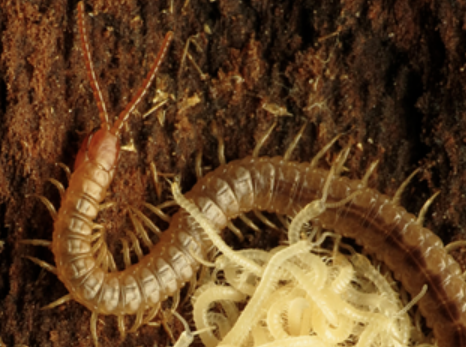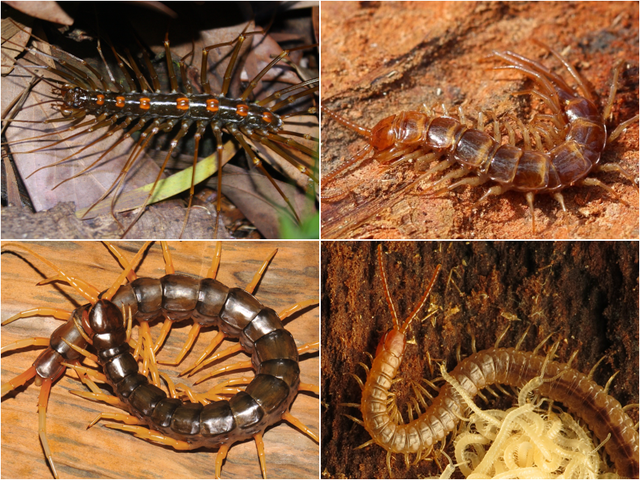
An encounter with a creepy, crawling, multi-legged centipede is an unpleasant event that may leave you feeling scared for days. Luckily, centipedes don’t live in groups or bite unprovoked, but you still probably want to get rid of them.
You can get rid of centipedes by trapping them alive and freeing them far away. Sticky traps or insecticides are effective ways of killing them. To stop centipedes from returning, eliminate their habitat and seal your home.
Centipedes are fairly simple to get rid of. Study this article for more detailed instructions for methods to eliminate centipedes learned from my years in the pest control industry.
You may also be interested in reading these related articles “How To Get Rid Of Moths” and “How To Get Rid Of Stink Bugs“.
What To Understand About Centipedes
Centipedes are arthropods, not insects, and there are as many as 8,000 types worldwide. While many centipedes use venom to subdue their prey, most centipede fangs are too small to hurt humans. A notable exception is the Florida blue centipede, which can pierce human skin with its bite and may cause a bee sting like wound.
Centipedes are long-living creatures, surviving as long as 10 years. A female centipede lays 15 to 60 eggs in a nest made in rotten wood or soil. They only use the nest for laying eggs and never return to it for any other purpose.
Despite their name, which means 100 feet, no centipede has 100 feet because they always have an odd number of leg pairs. Some centipedes have as few as 15 leg pairs but can have up to 191. Centipedes can detach legs to escape predators and then regrow them.
Where Do Centipedes Live?

Centipedes lack the waxy coating that many arthropods have to prevent water loss. Because of this lack, the preferred habitat of centipedes is damp and dark places.
In the wild, you might find centipedes living in piles of leaves, under rocks or in fallen logs. In your home, a centipede might stay near floor drains, basements or under the sink.
Centipedes are solitary creatures. If you find one centipede in your home, you don’t have to worry about finding dozens or hundreds more nearby.
What Do Centipedes Eat?
Centipedes are carnivores, and they primarily hunt other creatures to eat. Shockingly, tropical species can kill animals as large as birds and frogs. They immobilize their prey by stabbing them with their two front legs, which inject a paralyzing venom.
Around your house, centipedes might be beneficial because they kill other pests. Some household pests centipedes might like to snack on include:
- Cockroaches
- Flies
- Silverfish
- Termites
How To Get Rid Of Centipedes: Home Remedy
Fortunately, you probably only have to get rid of one centipede because they usually live alone. Your best option is to trap the centipede and release it somewhere outside, far away from your house.
Trapping A Centipede Alive
Centipedes are extremely fast. Try to corner it so that it can’t run anywhere to escape. You might also be able to wait for the centipede to stop moving and sneak up on it.
Use a glass or other container to cover the centipede. Next, slide a piece of paper under the container and lift the container with the centipede trapped in it.
Then, you can take the centipede outside and find a suitable place to release it. Try to put it near logs or rocks that the centipede might want to stay under instead of returning to your house.
Sticky Traps For Centipedes
If the centipedes in your house are too fast or scary to corner, a sticky trap could be a solution to get rid of them. Place sticky traps near the baseboards where you have seen centipedes.
Along with centipedes, you might trap other pests living in your house. These other pests could be the prey that the centipede is feeding on. Once you identify these other pests, you should take action to get rid of them, which would make your home less inviting to centipedes.
Be Aware: Sticky traps are a slow and painful death for critters that step on them. This may or may not be a problem for you, but you should understand what you’re doing.
What Kills Centipedes Instantly?
Most of the insecticides available in stores kill centipedes instantly. When choosing an insecticide, look for one containing cypermethrin or bifenthrin. These chemicals kill centipedes with one shot.
Always use caution when applying insecticides. Ensure that children and pets won’t come into contact with any chemicals. In that vein, follow all instructions that come with the insecticide and use personal protective equipment.
Should I Kill Centipedes?
Centipedes can be beneficial because they eat pests that could damage your home or make you sick. Still, there are some reasons you might want to kill centipedes, including:
- You are allergic to insect bites or bee stings, centipedes could be more dangerous to you.
- The fear of encountering a centipede stops you from enjoying your day.
- They continue to enter your house after you try non-lethal methods of getting rid of them.
Ultimately, you need to decide if killing centipedes is the right thing to do. Centipedes are critical to the ecosystem, but most people don’t like living near them.
Stopping Centipedes From Entering Your Home
If you can prevent centipedes from coming into your house, you won’t have to get rid of them again. As a bonus, many of the steps to stop centipedes from coming in also prevents other pests.
Outside Your House
Centipedes aren’t terrible to have in your yard, but you can get their pest-eating benefits without letting them inside your home. Centipedes need moist, dark places to live. If you keep these habitats a safe distance from your house, it’s less likely they will come inside.
Don’t have logs, lumber piles, big rocks or any objects that could trap moisture underneath near your house. You also need to keep your gutters working and fix drainage issues on your property.
If there are other pest infestations near your house, taking care of those will also bring down the number of centipedes. A balanced ecosystem supports healthy numbers of centipedes that won’t want to enter your home.
Inside Your Home
The best thing you can do to prevent centipedes is to identify and fix water leaks. Some signs of water leaks in your house are:
- Discolored patches on the walls or ceilings
- Damp spots, especially check under sinks.
- Low water pressure.
- Mold and mildew on the walls, ceiling or floor.
- A musty smell.
Next, fill all gaps and cracks around the house where centipedes could enter. Gap filling foam is a perfect method for stopping centipedes, but you could also get creative with some fine mesh screens or other items you have that can block holes.
On that note, put weatherstripping around windows and doors, which stops centipedes and helps make your home more energy efficient. Finally, install door sweeps under your home’s exterior doors.
Diatomaceous Earth To Prevent Centipedes
A natural method to create a centipede-killing barrier around your house is sprinkling a line of food-grade diatomaceous earth around the perimeter. Diatomaceous earth is a white powder made from fossilized diatoms.
The powder is highly abrasive and cuts the exoskeleton of centipedes and many other pests. After crawling through diatomaceous earth, centipedes dry out and die.
The best part is, this method is safe for pets and children and can be used indoors or outdoors. You will need to reapply diatomaceous earth every three to four weeks to maintain its effectiveness.
Signs Of House Centipede Infestation
The only way to tell you have centipedes in your house is the see them. In the end, centipedes don’t do any damage to buildings or leave a trail.
You may see a centipede walking across your floor when cleaning in a normally dark spot or in the bathroom stuck in your bathtub or sink. Unfortunately, centipedes have a habit of running at and scaring people.
Why Do I Suddenly Have Centipedes In My House?
For the most part, centipedes live outdoors. Some reasons centipedes might suddenly appear in your home include:
- During fall, they may seek a warm place to spend the winter.
- A new food source, like other pests, has infested your house.
- You changed your habits, such as rearranging furniture or using a room at a different time of day.
- There is a new source of water, like a leaking pipe.
Different Types Of Centipedes

With about 3,000 different named species, we won’t be describing each type. The most common kinds of centipedes that you might see in the USA are:
- House Centipede – This species originated in the Mediterranean but is now the most common centipede in North America and can grow to 1 ½ inch long. The house centipede can’t survive cold winters but can spend its entire life inside a warm building.
- Cryptoid Centipede – A light brown or reddish centipede that lives in the western USA. It can grow up to 2 ½ inches long and can bite humans if it feels threatened.
- Florida Blue Centipede – These bluish-gray 3-inch centipedes live in the southern USA. They tend to enter homes after heavy rains.